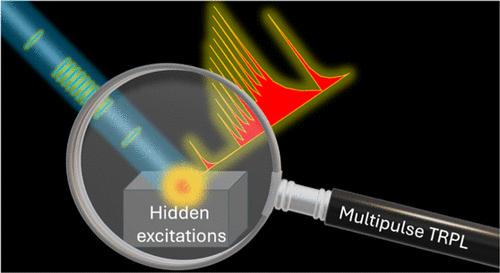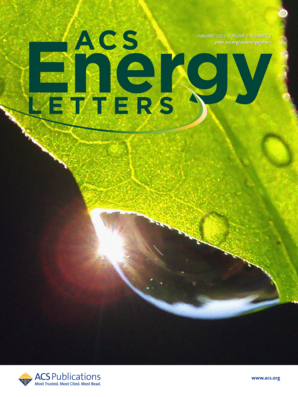Hidden Photoexcitations Probed by Multipulse Photoluminescence
IF 19.3
1区 材料科学
Q1 CHEMISTRY, PHYSICAL
引用次数: 0
Abstract
Time-resolved photoluminescence is a validated method for tracking the photoexcited carrier dynamics in luminescent materials. This technique probes the photoluminescence decays upon a periodic excitation by short laser pulses. Herein, we show that this approach cannot directly detect hidden photoexcitations with much slower dynamics than the photoluminescence decay. We demonstrate a new method based on a multipulse excitation scheme that enables an unambiguous detection and an easily interpreted tracking of these hidden species. The multipulse excitation consists of a single pulse (Read) followed by a burst of many closely separated pulses (Write) and finally another single pulse (Read). To illustrate the efficacy of the Read-Write-Read excitation scheme, we apply it to metal halide perovskites to directly visualize carrier trapping, extract the concentration of trapped charges, and determine the rate constant of trap depopulation. The developed approach allows studying performance-limiting processes in energy devices using a versatile, highly applicable all-optical method.

利用多脉冲光致发光探测隐藏的光激发
时间分辨光致发光是一种追踪发光材料中光激发载流子动态的有效方法。这种技术探测的是短激光脉冲周期性激发时的光致发光衰减。在这里,我们发现这种方法无法直接探测到动态比光致发光衰减慢得多的隐藏光激发。我们展示了一种基于多脉冲激发方案的新方法,该方法能够对这些隐藏物种进行明确的检测和简便的跟踪解释。多脉冲激发包括一个单脉冲(读取),然后是许多紧密分离的脉冲群(写入),最后是另一个单脉冲(读取)。为了说明 "读-写-读 "激发方案的功效,我们将其应用于金属卤化物包光体,以直接观察载流子捕获、提取捕获电荷的浓度并确定捕获物去隙的速率常数。所开发的方法允许使用一种多功能、高度适用的全光学方法来研究能源设备中的性能限制过程。
本文章由计算机程序翻译,如有差异,请以英文原文为准。
求助全文
约1分钟内获得全文
求助全文
来源期刊

ACS Energy Letters
Energy-Renewable Energy, Sustainability and the Environment
CiteScore
31.20
自引率
5.00%
发文量
469
审稿时长
1 months
期刊介绍:
ACS Energy Letters is a monthly journal that publishes papers reporting new scientific advances in energy research. The journal focuses on topics that are of interest to scientists working in the fundamental and applied sciences. Rapid publication is a central criterion for acceptance, and the journal is known for its quick publication times, with an average of 4-6 weeks from submission to web publication in As Soon As Publishable format.
ACS Energy Letters is ranked as the number one journal in the Web of Science Electrochemistry category. It also ranks within the top 10 journals for Physical Chemistry, Energy & Fuels, and Nanoscience & Nanotechnology.
The journal offers several types of articles, including Letters, Energy Express, Perspectives, Reviews, Editorials, Viewpoints and Energy Focus. Additionally, authors have the option to submit videos that summarize or support the information presented in a Perspective or Review article, which can be highlighted on the journal's website. ACS Energy Letters is abstracted and indexed in Chemical Abstracts Service/SciFinder, EBSCO-summon, PubMed, Web of Science, Scopus and Portico.
 求助内容:
求助内容: 应助结果提醒方式:
应助结果提醒方式:


